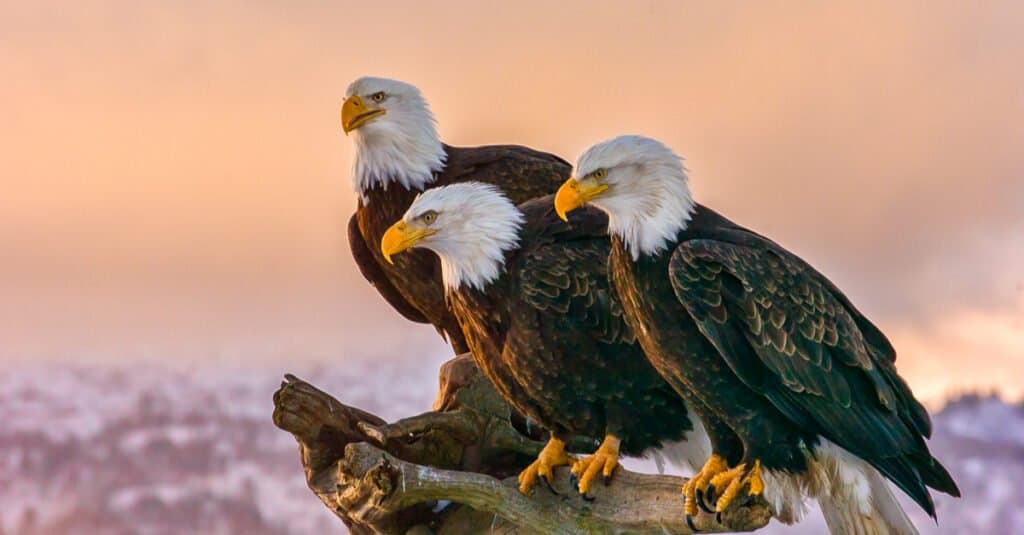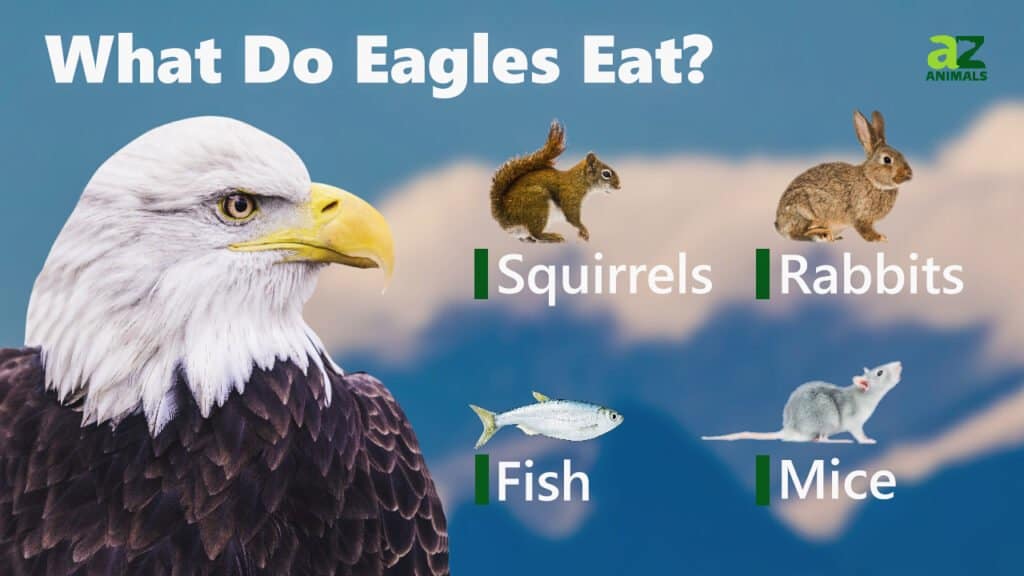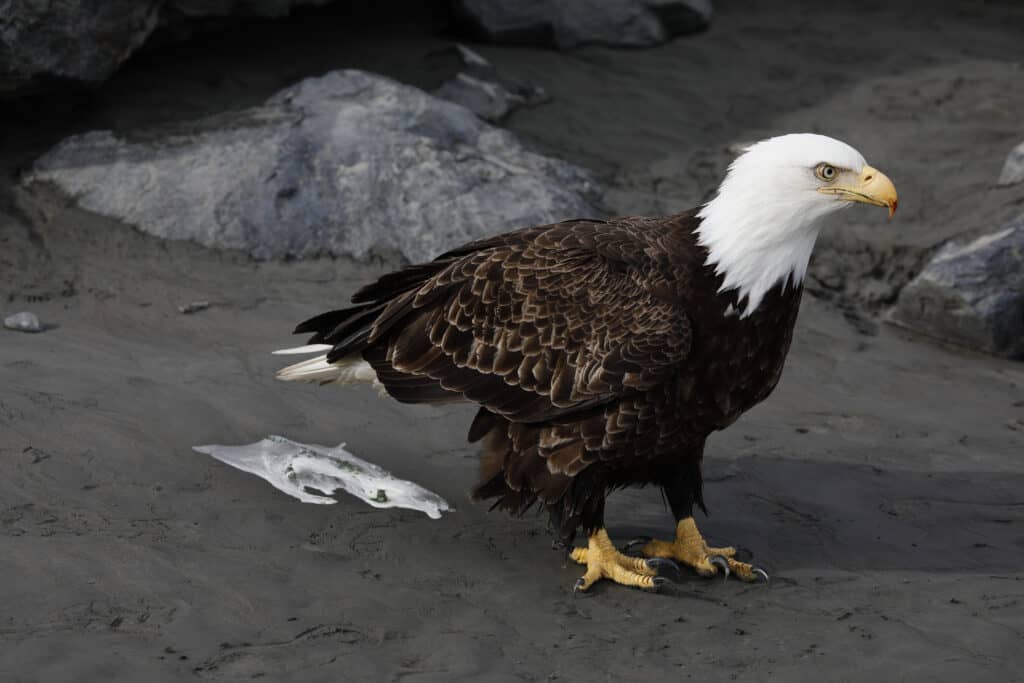Eagles are among the world’s largest birds! These powerful, intelligent predators are common in the United States. You’ve probably wondered at least once whether they resemble other birds or not. Well, they do, especially regarding their digestive system and poop! In fact, it would be difficult to tell an eagle’s poop from another bird’s waste. But why? Check out this article to find out the reason!
What are eagles?

Eagles are members of the
Accipitridaefamily.
©FloridaStock/Shutterstock.com
Eagles are members of the Accipitridae family, alongside vultures, hawks, and kites. They are classified into 60 extant eagle species that, in turn, are grouped into fish or sea eagles, forest eagles, booted eagles, and serpent eagles. Here are four of the most common eagle species:
- White-tailed eagles have brown body feathers, white tail feathers, and pale head and neck feathers.
- Golden eagles have dark brown feathers, pale wing feathers, and a golden nape.
- Bald eagles have white heads and tails and brown body feathers; the bald eagle is the national bird of the United States.
- Harpy eagles have gray bodies with white undersides and a black band across their necks.
Eagles are very large birds, with a wingspan of approximately 7-8 feet and weighing up to 20 pounds – in the case of larger species. Their heads are fully covered in feathers. They are birds of prey and make use of their hooked beaks to rip the flesh from the bone. Eagles also have very powerful talons.
Moreover, they possess excellent vision. For example, the martial eagle’s eyes are twice as large as a human’s, and their visual acuity is up to eight times stronger. This skill is attributed to their big pupils, the shape of the fovea, responsible for the sharp central vision, and the density of light-detecting cells in the retina.
Eagles usually live in nests built in tall trees or on high cliffs. These nests are called eyries. Most eagle species are sedentary, so they spend much of their time in their nests. However, some species migrate during winter.
These birds live in almost any habitat, including tundras, deserts, and rainforests. North America is abundant with bald eagles and golden eagles. However, a study shows that the golden eagle population has declined in the western United States. This is associated with shrub loss, jackrabbit population decline, and urbanization.
Other eagle species are endemic to Central and South America. Eagles are very common in Africa as well.
What do eagles eat?

Eagles are often called opportunistic eaters and predators. They aren’t picky when it comes to prey and will eat whatever they can find, which makes their diet a long list.
Eagles feed on fish, smaller birds, waterfowl, small mammals, rodents, and reptiles. They can sometimes delight in animals as big as deer or pigs!
Eagles do not chew their food. They either swallow it whole or break it into small pieces.
How does an eagle digest its food?
Although an eagle’s digestive system is similar to a human’s, some things can tell them apart. The first is the presence of a crop, where food can be stored for several days and “sent” to the stomach when the eagle needs it.
Another difference is the presence of the gizzard, which people don’t have. It’s a part of the stomach where food is ground into tiny pieces. This makes digestion easier and faster. This way, the eagle gets the nutrients and energy from its food more quickly. This is an essential step in the digestive process, as birds have a higher metabolic rate.
The gizzard is “home” to the so-called pellets. They are formed in the gizzard and may consist of fur, bones, or feathers. They usually appear after the eagle has eaten and are “vomited” through the mouth in the morning.
How do eagles poop?
Because eagles eat a lot and their digestive systems are quick, they poop a lot. Like other birds, eagles poop through the so-called “cloaca.” Sometimes it’s also called a vent.
What does eagle poop look like?
Eagle poop consists of white, gray, or brown watery waste. Other birds’ poop may have green tinges because some also feed on fruits and vegetables, which is not the case for eagles.
Why is eagle poop white?

Eagles poop and pee simultaneously because they don’t have a separate organ for peeing.
©iStock.com/R Lolli Morrow
The eagle poop’s white color is linked to the bird’s urine. Eagles poop and pee simultaneously because they don’t have a separate organ for peeing. That’s why an eagle’s poop (and any other bird’s poop) is called whitewash. Let’s see why their whitewash is white.
While absorbing the food with its nutrients to produce proteins and store energy, a bird’s body also produces nitrogenous waste. Nitrogenous waste appears as a result of proteins being broken into amino acids. This waste is toxic for the bird if it doesn’t leave the body in time.
People and other mammals also produce nitrogenous waste, but we get it out through urine by mixing it with water. However, since eagles don’t usually have freshwater sources and can survive long periods without drinking water, they can’t mix nitrogen-based waste with water. So they use the uric acid stored inside the egg to dissolve the waste. That’s how and why their excrements get the white color – from the uric acid.
Incredible eagle facts
- Eagles can see four to eight times farther than people! Besides this, they can also see ultraviolet colors!
- Eagles have 14 vertebrae on their necks, making them much more flexible and allowing them to turn their heads as needed.
- Eagles have an incredible lifespan! In the wild, eagles can live for about 30 years. In captivity, however, they can live up to 68 years!
- Baby eagles learn how to fly by themselves. They usually start flying when they get hungry because their parents don’t bring them food (which is a secret eagle tactic to motivate their babies to fly; pretty clever, isn’t it?!).
- Eagles don’t change partners unless one of them dies or disappears for more than a year. Male and female eagle partners have a powerful bond. They do everything together.
The photo featured at the top of this post is © Jack Molan/Shutterstock.com
Thank you for reading! Have some feedback for us? Contact the AZ Animals editorial team.






